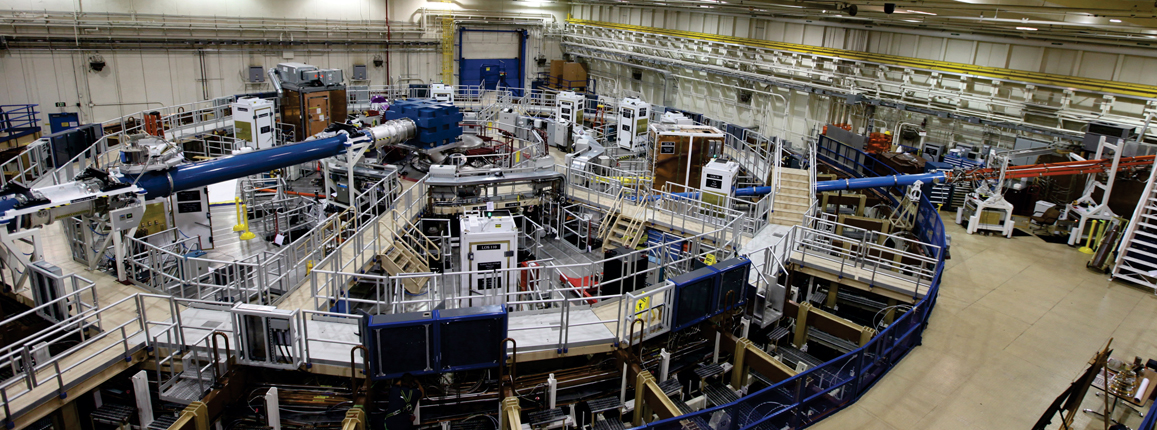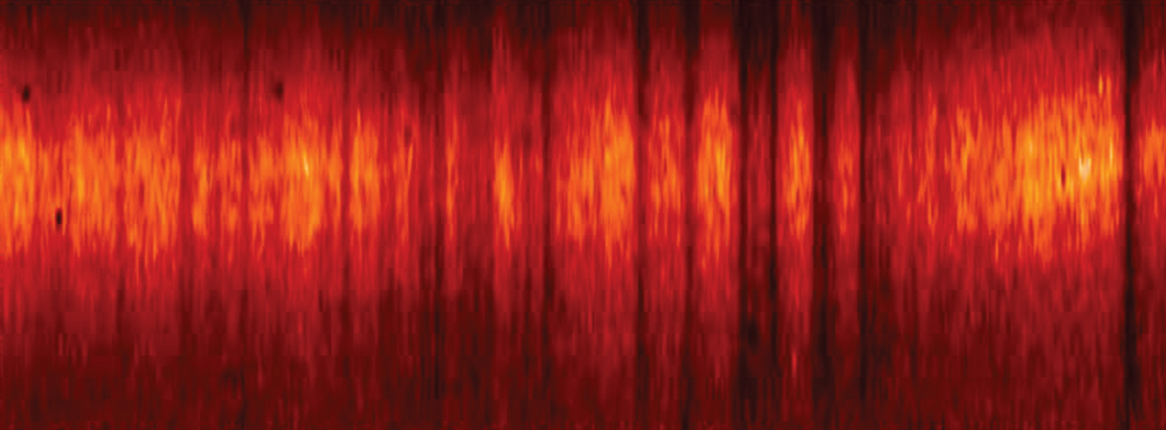Pulsed-power machine studies weapons, simulates stars
DOI: 10.1063/PT.3.2412
Whenever the Z machine is fired, the building that houses the pulsed-power scientists at Sandia National Laboratories in Albuquerque, New Mexico, rumbles. Some of the scientists have taken to measuring the building movement with the accelerometers on their laptops. Before each shot, a few hundred thousand gallons of insulating transformer oil are drained—so that the donut-shaped tank can be checked for damage—and then poured back; divers also check a central 6-meter-deep tank of deionized water to rid it of bubbles, which could potentially damage the machine by concentrating electric fields.
The Z machine is the world’s most powerful pulsed-power facility. With 2160 capacitors grouped into 36 radially arranged banks, Z can store up to 22 MJ. That energy is fired in a spatially and temporally compressed electromagnetic pulse at a target, which can be a cylindrical wire cage or a hollow tube or can contain a gas, liquid, or solid sample. As much as 3 MJ of electrical energy is delivered in as little as 100 ns. Experiments with a cylindrical target create what is known as a “z pinch”: The electrical current vaporizes the target, and the accompanying magnetic field pinches the resulting plasma inward. Upon implosion, kinetic energy is converted to heat; a target can radiate soft x rays in the range of 0.1–10 keV with a peak power up to 300 TW. (See Physics Today, June 1998, page 56

When energy slams a target at the center of the Z pulsed-power machine, the resulting x rays and plasmas are used to study materials, fusion, and astrophysics. The blue tube (left) carries the laser beam that is used for preheating plasmas and for radiographic imaging. X-ray power and energy diagnostics are placed at the far end of the blue and orange pipe (right).
MICHAEL JONES/SANDIA NATIONAL LABORATORIES

When the Z machine came on line in 1996, it was seen as a temporary retrofitting of a light-ion-beam facility. The idea was to try it out, and perhaps switch back and forth between the two experimental configurations. But the Sandia team never looked back. Instead, in 2006–07, a $90 million upgrade was undertaken. “It’s a completely different machine,” says Daniel Sinars, who oversees high-energy-density experiments at the facility. The outermost tank walls remained the same, he says, but the pulsed-power components are new. The energy was doubled, the peak current was increased, and better pulse-shaping capabilities were incorporated.
As part of the US nuclear weapons lab complex, Z has as its raison d’être the support of Science-Based Stockpile Stewardship, the nation’s program for monitoring nuclear weapons without detonating them. But some experiments—even if motivated by weapons work—involve fundamental, unclassified science, and 5–8% of the shots are dedicated to nonweapons work. The Z machine’s operations budget, which comes from the National Nuclear Security Administration (NNSA), is about $40 million this fiscal year. That translates to around 150 shots, split among materials research, radiation physics, and inertial confinement fusion (ICF). A small but growing fundamental science program at Z investigates matter at high-temperature, high-density conditions with astrophysical implications.
Inertial confinement fusion
Last November Sandia scientists did their first test of a new ICF configuration. The lab’s Steve Slutz came up with the idea for Magnetized Liner Inertial Fusion, or MagLIF, in which fusion fuel is compressed directly with the z pinch; previously Z drove fusion capsules with x rays—more along the lines of the lasers at the National Ignition Facility (NIF) at Lawrence Livermore National Laboratory (LLNL). One problem with using the z pinch, says Slutz, is that the 100-ns rise time of the current results in a relatively slow implosion. “With a slow implosion, any kind of energy loss will be exacerbated.” MagLIF overcomes that by applying a magnetic field to better contain the energy in the fusion fuel. “In some sense we split the difference between ICF and magnetic confinement fusion in tokamaks,” Slutz says. And preheating the fuel with a laser means less energy is needed to get the rest of the way to fusion. “So it’s premagnetized and hot,” says Kyle Peterson, who oversees ICF target design.
Sandia scientists test MagLIF by studying plasma instabilities with x-ray radiography as samples implode. Instabilities are “the biggest thing that has hindered all fusion approaches,” says Peterson. “That’s why we haven’t achieved fusion in the laboratory years ago.”
Even if Z or, more plausibly, a bigger pulsed-power facility were to get to ignition—in which the energy output exceeds the energy input—the approach would still be far from feeding a power grid. “For weapon-physics studies, being able to do one ignition-type experiment a week would be extraordinarily useful. But for energy you would need many more,” says Dawn Flicker, senior manager for high-energy-density material physics. The long-term goal of Sandia’s pulsed-power ICF program is high fusion yield, greater than 100 MJ per shot. “The hope is that if you can do that, maybe there is a path to energy,” Sinars says.
In the meantime, though, Sandia’s ICF team hopes that advances using MagLIF will help keep funding coming for ICF. In 2012 Congress called for a review of ICF because “NIF hadn’t yet lived up to its middle name,” as Sinars puts it. NIF had the stated goal of achieving ignition by the end of 2012. (See Physics Today, June 2013, page 20
Equations of state
About half of Z’s shots are devoted to studying materials at high temperatures and pressures. “We do experiments on plutonium, uranium, and explosives,” says Flicker. “How much can you compress a material? And how easy is it to bend the material? Those are the key properties.” Even studies of everyday materials such as aluminum, copper, and tantalum can aid in understanding the physics of nuclear weapons, she adds.
In compression experiments a sample is squeezed to high pressure, either abruptly to shock the sample or gently to minimize heating. “To first order, we can choose any material,” says Marcus Knudson. “We have done ramp compressions to 5 megabars. You get to high pressure at a relatively low temperature and stay solid.” Another target configuration is the flyer plate, in which a dime-sized metal disk is accelerated to high velocities to slam into the sample and generate a shock wave. For diagnostics, says Knudson, “we use velocimetry—we look at the Doppler shift of laser light that reflects from the sample.”
Laboratory astrophysics
In addition to providing a window into the behavior of nuclear explosions, the high-temperature, high-density materials studies give a glimpse into stellar and planetary interiors by creating conditions otherwise difficult or impossible to attain in the lab. For example, Knudson and colleagues measured the equation of state of water at very high pressures and densities to gain insight into the interior structure of ice giant planets. Another project involves studying the equations of state of materials to learn about high-energy impacts, such as when an asteroid hits a planet.
Scattered astrophysics experiments have been done at Z over the years, but in 2010 James Bailey and Greg Rochau organized four separate efforts under a single umbrella known as Z Astrophysical Plasma Properties. The ZAPP experiments study stellar interiors, black hole and x-ray binary accretion disks, active galactic nuclei, and white dwarf stars by using Z’s broadband, high-energy radiation to create plasma conditions not normally found on Earth. A single shot drives all four experiments, each designed to produce a uniform, long-lived (3–100 ns) plasma. The densities span six orders of magnitude and the temperatures vary by a factor of 200.
The stellar interiors project is motivated by disparities between models and helioseismic measurements. In recent years, explains Bailey, the inferred composition of the Sun has been revised, which led to changes in the calculated internal solar structure. As a result, the predicted location for the boundary that separates the inner radiative energy transport zone from the outer convective transport zone now disagrees with helioseismology. That boundary location depends on how much the solar matter attenuates radiation. Bailey and collaborators put iron about 1 mm from the z pinch to measure its opacity at 2.2 million kelvin, the temperature of the radiation–convection boundary in the Sun. “Our goal is to test the physical underpinnings of the models for the opacity,” he says. (See figure, above.)

Transmission through iron plasma, created by heating an iron foil with radiation from an implosion, is used to study aspects of stellar interiors. Incident photon energy increases to the right; the vertical axis represents the width of the foil.
JIM BAILEY/SANDIA NATIONAL LABORATORIES

Roberto Mancini of the University of Nevada, Reno, reproduces photoionizing conditions found in warm absorber plasmas around active galactic nuclei and in winds driven by black hole accretion disks. A cell filled with a mixture of neon and hydrogen gas sits about 5 cm from the z pinch; the pinch x rays turn the neutral gas into a photoionized plasma. “We want to understand the atomic physics and heating of this plasma for a range of ionization parameters,” Mancini says. “We are beginning to see qualitative similarities between our measurements and theoretical predictions, but the quantitative values are different. It’s very exciting.” In separate experiments silicon is photoionized to test a theory about differences in emissions from black hole and x-ray binary accretion disks.
The ZAPP white dwarf studies use the largest sample at the greatest distance, 35 cm, from the z pinch. X rays from the pinch heat a 12- by 1-cm gold foil. As the gold cools, its thermal radiation ionizes hydrogen to re-create conditions in a white dwarf photosphere. “Instead of looking at the light from a white dwarf and inferring the conditions, we are making the conditions and looking at the light,” says Ross Falcon, who is finishing his PhD at the University of Texas at Austin, on his ZAPP work. In particular, Falcon is testing new theoretical calculations that assign systematically more mass to white dwarfs.
Sandia officials see basic research as both intrinsically interesting and key to attracting and keeping good scientists at the weapons lab. “For my own research,” says Knudson, “I find the planetary side of things very rewarding. It’s a factor in keeping me here.”
More about the Authors
Toni Feder. tfeder@aip.org
